Near/far view discussion
+13
Justin Hervey
fiona
Sam Ogranaja
JimLewis
Hans van Meer.
marcus watts
stavros
Poink88
drgonzo
RYUGA
Todd Ellis
Robert Steven
theBalance
17 posters
Page 1 of 2
Page 1 of 2 • 1, 2 
 Near/far view discussion
Near/far view discussion
Hi,
two of the strongest indications for a near-view tree are :
1. Strong Trunk taper and a very wide trunk ( 1:6 ratio )
2. High level of details of dead wood
It is also known that If near view and far view features appear on the same tree, a confusing image is presented to the viewer – and it will not be considered “real”.
The subject of discussion I wanted to raise is about 2 complimenting questions :
Your opinions on how this type of trees can still be concived real would be very welcome,
alon
two of the strongest indications for a near-view tree are :
1. Strong Trunk taper and a very wide trunk ( 1:6 ratio )
2. High level of details of dead wood
It is also known that If near view and far view features appear on the same tree, a confusing image is presented to the viewer – and it will not be considered “real”.
The subject of discussion I wanted to raise is about 2 complimenting questions :
- What do you do with a material that have both near & far “view defining features” and are both part of the basic character of the tree – for example : a tree with very light tapering, but with a lot of interesting detailed natural jins and dead wood
- The literati style is exactly the style that represents the example above – and indeed it is confusing to see the high level details of the trunk and jin’s (as we would see from a near view ) but with almost no tapering – suggesting that we are seeing the tree from far
Your opinions on how this type of trees can still be concived real would be very welcome,
alon

theBalance- Member
 Re: Near/far view discussion
Re: Near/far view discussion
Hi Balance,
I discuss this in my second book "Mission of Transformation"...
There is nothing to do between close-up/distance view with trunk tapering because close-up view can be from bottom up, top down or eye level; and not every bonsai "tree" should have tapering trunk.
Shape of tapering, the placement of first branch etc (in certain styles)..will only affect the image of the tree, either you see the tree standing on the ground close to it, or from eye level or from top down (view the tree from higher level).
That's also the reason I do not agree the matematic rule of where you should set your first branch. The higher the first branch is, the more monumental your bonsai will look..and even more empahsized if you set the branches in such a way to show the ramification structure (when you look up to see a tree from the ground level in close, you will see more ramification structure).
The lower the first branch is, with more covered foliage, the shorter the bonsai will look, or like you see the tree from the higher level.
If you see a tall tree close-up from higher level, you won't see that much tapering..because tapering, beside the real trunk shape, it's also a matter of the perspective..like you look at a straight electric pole from very close bottom up, you will see the top as getting smaller; but if you look from the eye level to the same pole, you won't see the tapering...no matter how far...
What make a bonsai look unnature, as you say "confusing" of mixing of two features, close-up and distance view is the foliage form.
Most of our bonsai are suggesting close-up view with all the physical details, but many people style the foliage in such a densed, neat shape without any surface contour and foliage edges outline..then the bonsai will look unnature, artificial..because such foliation tree is only seen from a very far distance view.
No matter how dense the foliage of a tree is, if you see from close view, there are always contour on the surface as well as on the foliage edges outline, never very neat. There are always empty space in between, gaps..and not covered with extreme round dense foliage.
Have a look on a bonsai which people always say as "natural". What make it look natural ? It is simply because the bonsai has good ideal ramification structure..IRREGULAR shape and contour of the foliage with sufficient empty space. Just that simple....
That's why I always emphsize on good and ideal ramification, spare foliation with sufficient spaces in irregular shape, if you want your bonsai look natural.
Hope this help. Thanks and best bonsai regards...
I discuss this in my second book "Mission of Transformation"...
There is nothing to do between close-up/distance view with trunk tapering because close-up view can be from bottom up, top down or eye level; and not every bonsai "tree" should have tapering trunk.
Shape of tapering, the placement of first branch etc (in certain styles)..will only affect the image of the tree, either you see the tree standing on the ground close to it, or from eye level or from top down (view the tree from higher level).
That's also the reason I do not agree the matematic rule of where you should set your first branch. The higher the first branch is, the more monumental your bonsai will look..and even more empahsized if you set the branches in such a way to show the ramification structure (when you look up to see a tree from the ground level in close, you will see more ramification structure).
The lower the first branch is, with more covered foliage, the shorter the bonsai will look, or like you see the tree from the higher level.
If you see a tall tree close-up from higher level, you won't see that much tapering..because tapering, beside the real trunk shape, it's also a matter of the perspective..like you look at a straight electric pole from very close bottom up, you will see the top as getting smaller; but if you look from the eye level to the same pole, you won't see the tapering...no matter how far...
What make a bonsai look unnature, as you say "confusing" of mixing of two features, close-up and distance view is the foliage form.
Most of our bonsai are suggesting close-up view with all the physical details, but many people style the foliage in such a densed, neat shape without any surface contour and foliage edges outline..then the bonsai will look unnature, artificial..because such foliation tree is only seen from a very far distance view.
No matter how dense the foliage of a tree is, if you see from close view, there are always contour on the surface as well as on the foliage edges outline, never very neat. There are always empty space in between, gaps..and not covered with extreme round dense foliage.
Have a look on a bonsai which people always say as "natural". What make it look natural ? It is simply because the bonsai has good ideal ramification structure..IRREGULAR shape and contour of the foliage with sufficient empty space. Just that simple....
That's why I always emphsize on good and ideal ramification, spare foliation with sufficient spaces in irregular shape, if you want your bonsai look natural.
Hope this help. Thanks and best bonsai regards...
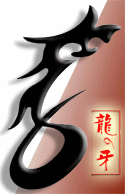
Robert Steven- Member
 Re: Near/far view discussion
Re: Near/far view discussion
Look at this bonsai..
No tapering, we can tell it is very high and close to us, but we can also tell that we look at this "tree" from a higher lavel and not from the ground... These are all suggested by the setting of the foliage form and the ramification structure.
If we set to show more ramification structure, especially the branches line on this tree, it will immediately look like we see from closer and lower level.

And look at this tree..no tapering, but we can tell from the exposing ramification, that we look at this tree from close-up ground..

And here a nother example of bonsai that suggesting a longer distance view. Less trunk details, more dense and neat foliation and the leaves size...
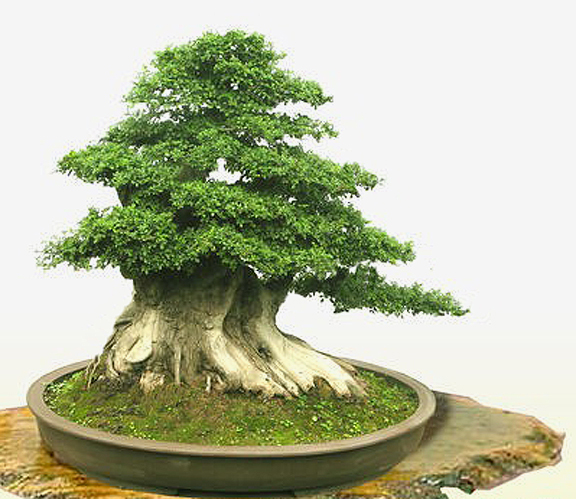
No tapering, we can tell it is very high and close to us, but we can also tell that we look at this "tree" from a higher lavel and not from the ground... These are all suggested by the setting of the foliage form and the ramification structure.
If we set to show more ramification structure, especially the branches line on this tree, it will immediately look like we see from closer and lower level.

And look at this tree..no tapering, but we can tell from the exposing ramification, that we look at this tree from close-up ground..

And here a nother example of bonsai that suggesting a longer distance view. Less trunk details, more dense and neat foliation and the leaves size...


Robert Steven- Member
 Re: Near/far view discussion
Re: Near/far view discussion
I am glad that Robert replied to your question. I was thinking that "near versus far" is really only relevant when composing a forest or other grouping when perspective is necessary. Aside from that the tree (s) speaks for itself.
Robert, your Sageritia is beautiful. How is the rock/tree attached to the pot? Is the rock drilled for wire?
Thanks,
Todd
Robert, your Sageritia is beautiful. How is the rock/tree attached to the pot? Is the rock drilled for wire?
Thanks,
Todd
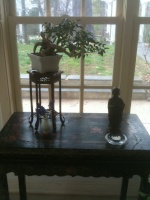
Todd Ellis- Member
 Re: Near/far view discussion
Re: Near/far view discussion
Thanks Todd.
These trees are not mine, I just use them for examples.
Normally for such rock, it is glued to the pot with cement.
You are right, close-up/distance view also apply on forest/ grouping.
- Close up forest normally uses less numbers of threes, their sizes difference are more significant with one or two large trees to be set as focal point, and each tree is trained in detail like we do on individual bonsai.
- Long distance view uses more numbers of trees, sizes difference is not significant, focul point is set by a group of trees or the height, and the overall silhouette composition shape is more important than the individual detail.
These trees are not mine, I just use them for examples.
Normally for such rock, it is glued to the pot with cement.
You are right, close-up/distance view also apply on forest/ grouping.
- Close up forest normally uses less numbers of threes, their sizes difference are more significant with one or two large trees to be set as focal point, and each tree is trained in detail like we do on individual bonsai.
- Long distance view uses more numbers of trees, sizes difference is not significant, focul point is set by a group of trees or the height, and the overall silhouette composition shape is more important than the individual detail.

Robert Steven- Member
 Re: Near/far view discussion
Re: Near/far view discussion
The way I work with it is to look at the tree (as it is) and ask myself.
'When I see this tree am I at a distance or am I right up underneath it?' The answer I come up with determines the "view" and I just style and pot it accordingly from there. For me its a broad determination thats not exclusionary of taper or jins or branches etc...
I have far view single trees as well as forests, Many trees in Tomlinson's book are far view single trees. I happen to like far view as its the way I usually see trees in nature, at a distance, where I can admire them in their full resplendence. Though I find I am beginning to warm to the "sumo's" a bit.
-Jay
'When I see this tree am I at a distance or am I right up underneath it?' The answer I come up with determines the "view" and I just style and pot it accordingly from there. For me its a broad determination thats not exclusionary of taper or jins or branches etc...
I have far view single trees as well as forests, Many trees in Tomlinson's book are far view single trees. I happen to like far view as its the way I usually see trees in nature, at a distance, where I can admire them in their full resplendence. Though I find I am beginning to warm to the "sumo's" a bit.
-Jay
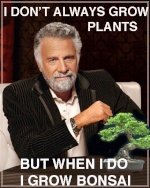
drgonzo- Member
 the real problem
the real problem
Hi Robert,
first of all, I have both of your books ( looking forward for the third one ). regarding your second book “mission of transformation” is simply so full of knowledge, and is simply the BEST bonsai book I have read ( and I have lots ), it is so inspirational !
), it is so inspirational !
and I did read about the canopy / negative spaces/… and I agree..
I have read yours and the others feedback, and I understood that I didn't ask the real question.
my real problem is as follow :
the more my bonsai have fine & interesting details…
the more it is suitable for a near-view style…
and the more it is hard to create an illusion of a BIG tree.
Because the fine details are suggesting a very close viewing…but they are part of the tree...so the tree itself looks smaller..
so you need to create a strong perspective illusion by “tricks” ( trunk tapering, descending interval between branches, tree top is leaning toward the viewer )
the more "perspective" tricks you use..the more the tree will look good from only one front and BAD & un-natural from the other sides
what do you think about this paradox ? is there a diffrent way of looking & solve this - when you want to create a bonsai with fine details that will be concived as BIG tree and will look good from all around.
or is this a dream
first of all, I have both of your books ( looking forward for the third one ). regarding your second book “mission of transformation” is simply so full of knowledge, and is simply the BEST bonsai book I have read ( and I have lots
and I did read about the canopy / negative spaces/… and I agree..
I have read yours and the others feedback, and I understood that I didn't ask the real question.
my real problem is as follow :
the more my bonsai have fine & interesting details…
the more it is suitable for a near-view style…
and the more it is hard to create an illusion of a BIG tree.
Because the fine details are suggesting a very close viewing…but they are part of the tree...so the tree itself looks smaller..
so you need to create a strong perspective illusion by “tricks” ( trunk tapering, descending interval between branches, tree top is leaning toward the viewer )
the more "perspective" tricks you use..the more the tree will look good from only one front and BAD & un-natural from the other sides
what do you think about this paradox ? is there a diffrent way of looking & solve this - when you want to create a bonsai with fine details that will be concived as BIG tree and will look good from all around.
or is this a dream

theBalance- Member
 Re: Near/far view discussion
Re: Near/far view discussion
I agree with Jay. I am simplistic as well...for me, you need a frame/foundation...the rest follows. I don't even know about near far until now  For me, details (properly done) help create illusion of age...there is never a conflict in my mind.
For me, details (properly done) help create illusion of age...there is never a conflict in my mind.
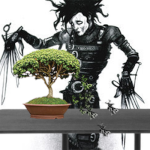
Poink88- Member
 details and size
details and size
hi Jay,
I would try to explain...
please look at this :
http://julielea.files.wordpress.com/2010/10/bonsai1.jpg
your brain is looking at the focal point - the most interesting and complex detail in this bonsai, and it also suggest that the size of that hole...according to your previous expirience - let's say ( just to explain ) that we think that it's a HUGE hole with a hight of 1 meter..then...the hight of the tree is about 3 times the "hole" so the tree is concived as a small tree - only a 3 meter high.
my example can be not accurate but I hope I've managed to explain the principle.
also please notice that the leaves on the buttom branches have the same size like the leaves on the top branches ( like in all trees ), so the "perspective" is canceled
), so the "perspective" is canceled
what changes can you make to this tree so it will be concived as a BIG tree ?
I would try to explain...
please look at this :
http://julielea.files.wordpress.com/2010/10/bonsai1.jpg
your brain is looking at the focal point - the most interesting and complex detail in this bonsai, and it also suggest that the size of that hole...according to your previous expirience - let's say ( just to explain ) that we think that it's a HUGE hole with a hight of 1 meter..then...the hight of the tree is about 3 times the "hole" so the tree is concived as a small tree - only a 3 meter high.
my example can be not accurate but I hope I've managed to explain the principle.
also please notice that the leaves on the buttom branches have the same size like the leaves on the top branches ( like in all trees
what changes can you make to this tree so it will be concived as a BIG tree ?

theBalance- Member
 Re: Near/far view discussion
Re: Near/far view discussion
theBalance wrote:
what changes can you make to this tree so it will be concived as a BIG tree ?
Ugh! I'm the last person you should be asking for stylistic advice!
But, I would extend the lower foliage branches down and allow the right hand bottom foliage to lengthen. Bringing the lower foliage down and outwards horizontally might help to make the tree look more "squat" and less tall, you could nip the apex down a bit to. but ultimately these are changes in dimension (heights and widths) not changes in details or intricacy.

drgonzo- Member
 Re: Near/far view discussion
Re: Near/far view discussion
FYI, the tree you are referring to belongs to a IBC member, Ian Warhurst. I think it's an escalonia.
It was shown also at the Best of British Bonsai 2011in Birmingham.
It was shown also at the Best of British Bonsai 2011in Birmingham.
stavros- Member
 Re: Near/far view discussion
Re: Near/far view discussion
Hi,
many of our most pleasing creations actually look like 'bonsai' rather than having to all look like 'real' trees - Personally I feel an interesting and varied personal collection will have trees of both types -with my trees I like to stand back and look from many meters away as this is the way for me to enjoy the whole scene, and then others will get their noses right up close to the same tree to see the details - (as I do when I'm working on them or studying them rather than just looking for pleasure). Because of the fact we can actually move back, or forward, to change our view a good tree can have the fine details when you poke your nose in and a nice balance of trunk, foliage mass and spaces from further back.
There is no rule saying a bonsai must be viewed from 1.5 meters away and therefore must be styled to look simply near or far, this is just one of the many options available to both stylist and viewer.
cheers Marcus
many of our most pleasing creations actually look like 'bonsai' rather than having to all look like 'real' trees - Personally I feel an interesting and varied personal collection will have trees of both types -with my trees I like to stand back and look from many meters away as this is the way for me to enjoy the whole scene, and then others will get their noses right up close to the same tree to see the details - (as I do when I'm working on them or studying them rather than just looking for pleasure). Because of the fact we can actually move back, or forward, to change our view a good tree can have the fine details when you poke your nose in and a nice balance of trunk, foliage mass and spaces from further back.
There is no rule saying a bonsai must be viewed from 1.5 meters away and therefore must be styled to look simply near or far, this is just one of the many options available to both stylist and viewer.
cheers Marcus

marcus watts- Member
 Re: Near/far view discussion
Re: Near/far view discussion
And that's why you should not creat detailed deadwood on a Bonsai that is styled to look like a tree in the distance! Normally we would not be able to see all those details on a tree fare away! So if you creat to much details in your deadwood on a distance image Bonsai, you will distroy the illusion of distance that you wanted to show to the viewer!
I think that the proper use of open spaces in your work is the fastest way to give the viewer a instant idea of just how fare away the tree on display is pretending to be growing from us! From there, with that knowledge in the back of the viewers heads, they can much more enjoy the rest of the illusion that you created! If the viewer, when looking at your tree, first has to struggle to find out how fare and how big this tree is supposed to be, they most likely wont understand what you were after when you styled your Bonsai! And that's a shame!
Just my two cents!
Good post Robert!
Cheers,
Hans van Meer.
I think that the proper use of open spaces in your work is the fastest way to give the viewer a instant idea of just how fare away the tree on display is pretending to be growing from us! From there, with that knowledge in the back of the viewers heads, they can much more enjoy the rest of the illusion that you created! If the viewer, when looking at your tree, first has to struggle to find out how fare and how big this tree is supposed to be, they most likely wont understand what you were after when you styled your Bonsai! And that's a shame!
Just my two cents!
Good post Robert!
Cheers,
Hans van Meer.

Hans van Meer.- Member
 Re: Near/far view discussion
Re: Near/far view discussion
marcus watts wrote:Hi,
many of our most pleasing creations actually look like 'bonsai' rather than having to all look like 'real' trees - Personally I feel an interesting and varied personal collection will have trees of both types -with my trees I like to stand back and look from many meters away as this is the way for me to enjoy the whole scene, and then others will get their noses right up close to the same tree to see the details - (as I do when I'm working on them or studying them rather than just looking for pleasure). Because of the fact we can actually move back, or forward, to change our view a good tree can have the fine details when you poke your nose in and a nice balance of trunk, foliage mass and spaces from further back.
There is no rule saying a bonsai must be viewed from 1.5 meters away and therefore must be styled to look simply near or far, this is just one of the many options available to both stylist and viewer.
cheers Marcus
All good points, but when you do choose to style your Bonsai as a near or fare away looking tree, well than you should follow that trough in all the aspect of the tree. Roots, branches, deadwood and other things with or with out details and last but not least the open or negotive spaces. If something in your design of a fare away tree, contradicts that same fact. Well than the illusion wound work! And I think that this counts for most styles in Bonsai!
Cheers,
Hans van Meer.

Hans van Meer.- Member
 Re: Near/far view discussion
Re: Near/far view discussion
Stavros - 10x for the info, the tree is just an example, and a very lovely bonsai 
Marcus 10x for the magic words : "many of our most pleasing creations actually look like 'bonsai' rather than having to all look like 'real' trees ".
Hans – I am so totally agree with you ! about ALL the things you said. But I am asking something a bit different. I will try again.
Suppose I have a Yamadori with a lot of details in his deadwood – my questions :
Marcus 10x for the magic words : "many of our most pleasing creations actually look like 'bonsai' rather than having to all look like 'real' trees ".
Hans – I am so totally agree with you ! about ALL the things you said. But I am asking something a bit different. I will try again.
Suppose I have a Yamadori with a lot of details in his deadwood – my questions :
- does this automatically suggest that it will be designed as a near-view bonsai ?
- Can anyone show such a tree ( with a lot of details in his dead wood ) that looks like a HUGE tree ( let's say more then 15 meters ) ? or because of the fine details there is no way of creating this because we will need to create a too much strong perspective ( we are close to the buttom, and the top needs to be seen as very far from us )

theBalance- Member
 Re: Near/far view discussion
Re: Near/far view discussion
This is a very interesting discussion and I don't want it to stop soon, so herewith a Very Gentle Reminder that we need to be careful about using pictures of trees that are not ours or that are taken from a book without permission.

JimLewis- Member
 Re: Near/far view discussion
Re: Near/far view discussion
If we don't own the copyrights we can only post links, is that right Jim? I'm just asking because I'd like to post a picture of Louis Nel's (RIP) famous Buddleja Saligna, for my own understanding of this concept.
I love this topic. I'll try to add more later, when I'm not working.
Thanks to all who are contributing!!!!
Sam
I love this topic. I'll try to add more later, when I'm not working.
Thanks to all who are contributing!!!!
Sam

Sam Ogranaja- Member
 Re: Near/far view discussion
Re: Near/far view discussion
Hi Sam. Posting a link (as theBalance did) is quite okay as it makes it clear that you are not claiming the pic as your own.

fiona- Member
 Re: Near/far view discussion
Re: Near/far view discussion
fiona wrote:Hi Sam. Posting a link (as theBalance did) is quite okay as it makes it clear that you are not claiming the pic as your own.
Thank you, Fiona. This is the link to the tree I'd like to ask about. What do you guys think, near or far view?
http://www.artofbonsai.org/art-of-bonsai-awards/2009/aob_154_buddleja_saligna.jpg
Have a great week!!
Sam

Sam Ogranaja- Member
 Re: Near/far view discussion
Re: Near/far view discussion
Hi Balance,
Just a quick comment as I am at the airport to China...
Although one of the basic philosophy of bonsai is a miniature size of mature tree in the pot, but it does not mean that we should make every details in correct scale, otherwise most of the bonsai are not valid.
As an art form design, in bonsai, we are more in conveying the implicit message through the explicit beauty. We are playing with symbols, illusion to suggest certain nuance, mimic to express our idea. In the case of the physical features and details of the tree, we are simply resembling the big mature tree in nature, but we are not creating a miniature prototype in correct scaling.
So, at least for me, I rather concern the morphological aspect of my bonsai, make it talk to portray where it grow in nature and succeed to make the viewer imagine what condition that "create" the form. However, with the design principles I described before, we still can make our bonsai to suggest certain viewing distance...
Well...will get to the plane soon...
Just a quick comment as I am at the airport to China...
Although one of the basic philosophy of bonsai is a miniature size of mature tree in the pot, but it does not mean that we should make every details in correct scale, otherwise most of the bonsai are not valid.
As an art form design, in bonsai, we are more in conveying the implicit message through the explicit beauty. We are playing with symbols, illusion to suggest certain nuance, mimic to express our idea. In the case of the physical features and details of the tree, we are simply resembling the big mature tree in nature, but we are not creating a miniature prototype in correct scaling.
So, at least for me, I rather concern the morphological aspect of my bonsai, make it talk to portray where it grow in nature and succeed to make the viewer imagine what condition that "create" the form. However, with the design principles I described before, we still can make our bonsai to suggest certain viewing distance...
Well...will get to the plane soon...

Robert Steven- Member
 Re: Near/far view discussion
Re: Near/far view discussion
Sam Ogranaja wrote:This is the link to the tree I'd like to ask about. What do you guys think, near or far view?
http://www.artofbonsai.org/art-of-bonsai-awards/2009/aob_154_buddleja_saligna.jpg
Have a great week!!
Sam
My comment is..refer to my description before, and the artist know better if he want to suggest a close-up view or a distance view and how successful it makes the viewers get the same message...

Robert Steven- Member
 Re: Near/far view discussion
Re: Near/far view discussion
theBalance wrote:
Hans – I am so totally agree with you ! about ALL the things you said. But I am asking something a bit different. I will try again.
Suppose I have a Yamadori with a lot of details in his deadwood – my questions :
- does this automatically suggest that it will be designed as a near-view bonsai ?
No, not necessarily. If all other features of the tree point to, lets say a formal upright or Literati, than you go in that direction! Than you must try to find a balance between the two. When the proportions of the deadwood are brought in line with the style and the distance that goes along with it, then the tree will look just fine! The natural cracked lines in the deadwood might be still to big and rough, but that will only be a bonus, when that balance is found!
theBalance wrote:Can anyone show such a tree ( with a lot of details in his dead wood ) that looks like a HUGE tree ( let's say more then 15 meters ) ? or because of the fine details there is no way of creating this because we will need to create a too much strong perspective ( we are close to the buttom, and the top needs to be seen as very far from us )
Here is partly virtual of my very old (600+) Pinus Uncinata that sadly died two years ago, just a few years before it was finished. This tree was realy close to this virtual that I had made a few years earlier. 99% of this ancient tree was amazingly detailed deadwood, but still I tried to make a huge distant fantasy tree out of the one living branch. I realised that it would not be logical, but it was what I saw in the tree and I knew right from the start that if I could make these two opposites work together, than I would have created someting special! So yes it can and should be don when the tree dictates you into that direction!

The foliage and branches tell of a big tree, not to fare away in the distance. And I believe that if that foliage and empty spaces in the image are convincing, well than you can count on the fantasy of the viewer to do the math and than the deadwood will just fit in nicely in to that total picture!
Sorry for high jacking your post Robert!
Cheers,
Hans van Meer.
Last edited by Hans van Meer. on Tue Feb 28, 2012 1:16 am; edited 1 time in total (Reason for editing : typo)

Hans van Meer.- Member
 Re: Near/far view discussion
Re: Near/far view discussion
Have a safe and pleasant flight Robert! 
Cheers,
Hans van Meer.
Cheers,
Hans van Meer.

Hans van Meer.- Member
 Re: Near/far view discussion
Re: Near/far view discussion
Thanks Han, absolutely no problem, this is where we share our thought..and this is not my thread anyway... 
Nice tree Han... and hope I still can get good connection in China.
Nice tree Han... and hope I still can get good connection in China.
Last edited by Robert Steven on Tue Feb 28, 2012 1:18 am; edited 1 time in total (Reason for editing : mistype)

Robert Steven- Member
Page 1 of 2 • 1, 2 
 Similar topics
Similar topics» No shohin discussion
» Midwest show discussion question
» Follow on to - Kevin's discussion of reality
» San jose juniper
» a view from my yard
» Midwest show discussion question
» Follow on to - Kevin's discussion of reality
» San jose juniper
» a view from my yard
Page 1 of 2
Permissions in this forum:
You cannot reply to topics in this forum







